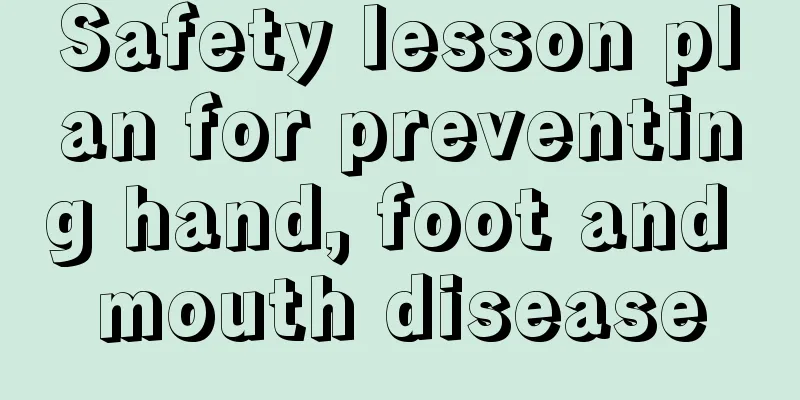Safety lesson plan for preventing hand, foot and mouth disease

|
Hand, foot and mouth disease related educational courses are often held, which can prevent the occurrence of hand, foot and mouth disease, and at the same time avoid the spread of hand, foot and mouth disease more quickly. To prevent hand, foot and mouth disease, you must pay attention to washing your hands and do regular inspections. In addition, try not to go to crowded places. Even if you go, do not touch things randomly. Washing hands before eating is necessary because it can prevent the invasion of bacteria. Activity Objectives 1. Understand the knowledge about the transmission and prevention of hand, foot and mouth disease. 2. Educate children to pay attention to personal and dietary hygiene to prevent the occurrence of diseases. 3. Guide young children to treat hand, foot and mouth disease correctly and not panic. Key points of the activity: Understand the transmission and prevention measures of hand, foot and mouth disease. Activity Process 1. Conversation introduction Children, every day your teachers will take your temperature, check your hands and mouths. Does anyone know why? (Ask the children to tell the story) 2. Introduction to basic knowledge of hand, foot and mouth disease 1. It seems that the children already know about hand, foot and mouth disease. What are the symptoms of hand, foot and mouth disease? (Children's discussion) Conclusion: Symptoms: The incubation period is 2-5 days, and fever symptoms often appear first, with maculopapular rashes on the palms and soles, and herpes or ulcers on the oral mucosa, which are very painful. There will also be coughing, runny nose, loss of appetite, nausea, vomiting, and headaches. Severe cases may develop encephalitis, myocarditis, pneumonia, etc., which can be life-threatening if not treated in time. Therefore, when children feel unwell, they should tell teachers and adults immediately and seek medical attention in a timely manner. How are hand, foot and mouth disease germs spread? (Children's discussion) Summary: Transmission routes of hand, foot and mouth disease: Hand, foot and mouth disease is an infectious disease caused by enterovirus and is common in children. It is mainly transmitted through three routes: one is close contact between people; the second is the transmission of the patient's secretions and excretions through the air; the third is drinking or eating water or food contaminated by the patient. Fecal-oral transmission is the main route of transmission. We will get sick if we come into contact with toys and books that have been touched by sick children, or food that has been bitten or crawled by flies carrying the virus. The disease can occur throughout the year, but is more common from March to November, with a peak from June to August. This disease spreads very quickly. 3. Know how to prevent hand, foot and mouth disease. Summary: Preventive measures: (1) Maintain oral hygiene and rinse your mouth after meals. (2) Wash hands in the morning before entering the kindergarten, before meals, and after defecation (use soap, following the six-step hand washing method), trim nails frequently, and take a bath frequently. (3) Healthy young children can take drugs such as Isatis Root and Isatis Indigotica orally. (4) Avoid going to crowded public places. Do not visit neighbors frequently; do not come into contact with sick children. (5) When parents come home from outside, ask them to wash their hands and change their clothes immediately to prevent them from bringing in germs. (6) Wipe the table with an 84 rag before meals and do not eat raw or cold food. In summer, eat less cold drinks and do not drink raw water. Wash and peel fruits and vegetables and do not eat spoiled food. Young children should strengthen their nutrition, not be picky about food, pay attention to rest, avoid exposure to sunlight, and prevent excessive fatigue which reduces their resistance. (7) Keep the activity room or home environment clean and open windows frequently for ventilation, at least once every two hours, for more than half an hour each time. Garbage should be cleaned and disinfected in a timely manner. 4. Organize competition activities. (1) Compare whose hands are the cleanest. The children all know what hand, foot and mouth disease is and how to prevent it. Now, let’s see who can wash their hands the cleanest. Wash hands in groups and select the child who washes hands most seriously. |
<<: Will hand, foot and mouth disease recur? Will hand, foot and mouth disease recur?
>>: What foods should be avoided for hand, foot and mouth disease
Recommend
What causes a newborn baby to have a big head?
A newborn's big head is a very troublesome pr...
What to do if your child has a fever and wants to sleep
Every time a child has a fever, parents will feel...
What to do if children have less hair
Many babies have very little hair when they are b...
Symptoms of urinary tract infection in boys
Some babies will suffer from urinary tract infect...
Baby nails are purple
I recently saw a special interview on TV. There w...
Reasons for decreased appetite in two-month-old babies
In daily life, many mothers have found that many ...
Baby has diarrhea and hasn't urinated
Diarrhea is one of the most common symptoms in ba...
Things to note when a 5-year-old child loses teeth
The age of 5 is the time when children change the...
Can you touch a newborn's head?
The skin of a newborn baby is relatively delicate...
How to treat acute suppurative tonsillitis in children
Tonsillitis is a common disease in the throat. Th...
What's wrong with my child's cold hands, dizziness and chest tightness?
Children's physical development is very fast,...
Can children eat fried scorpions?
Although scorpions look very scary, they are actu...
How to give injections to children
No one likes injections, but they are an inevitab...
A complete guide to home care for children with fever
What should I do if my baby has a fever? Parents ...
What to do if your child has tooth decay
No one can ignore the important role that teeth p...









